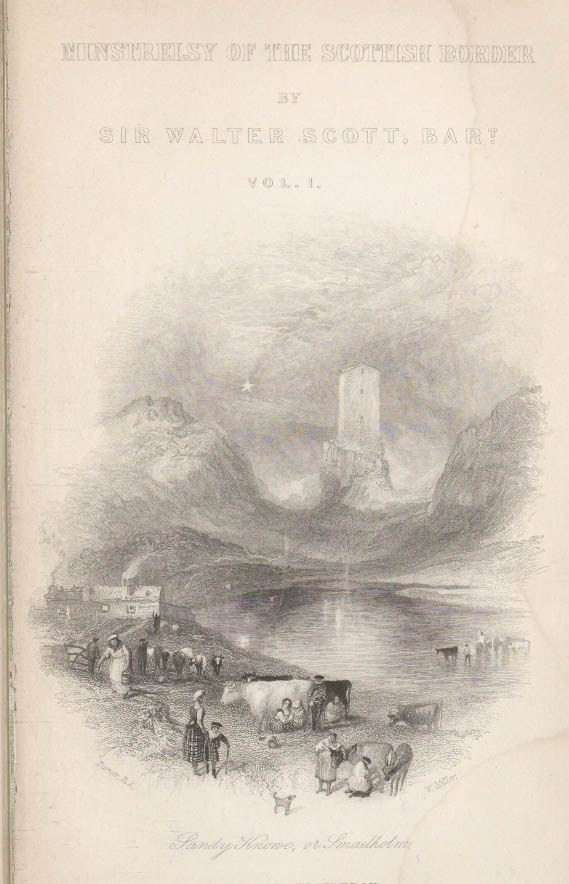15 August 2021 marks the 250th anniversary of the birth of one of Scotland’s most famous authors, who in his lifetime achieved global renown and for millions came to represent Scotland and Scottish culture. Sir Walter Scott’s fame may have declined somewhat over the last 100 years, and his works are not so widely read, but he has had a huge and lasting influence on later generations of authors, not just in the English-speaking world but also in Continental Europe. His works were translated, adapted into plays, operas, and later into film scripts. His popularity led to the rapid growth of the Scottish tourist industry in the 19th century for travellers eager to visit the sites depicted in Scott’s poems and novels.
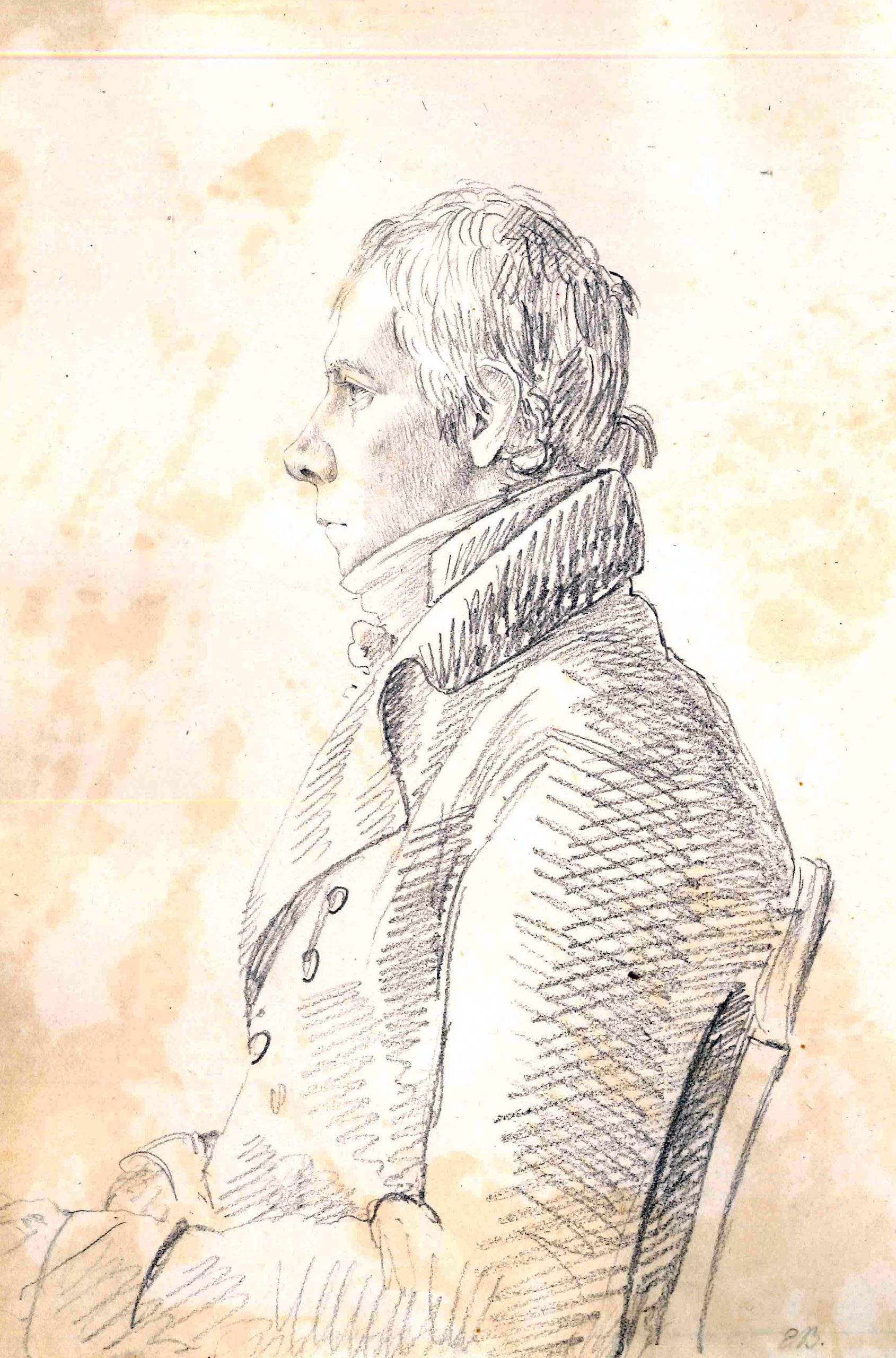
A drawing thought to portray Walter Scott c. 1803
This blog focuses on the publication history behind one of Scott’s earliest works, ‘Minstrelsy of the Scottish Border’, first published in 1802. When it first appeared in print Scott was a relative unknown outside of Scotland. He was simply Walter Scott the advocate, based in Edinburgh but with his roots in the Scottish Borders. His published output had so far consisted of two translations of German poems, and three privately printed works, none of which had made an impact. Scott had visited London in 1799 but had failed to make a name for himself among the men of letters in the capital city, apart from a friendship with Matthew Lewis, author of the gothic novel ‘The Monk’. That same year he had the consolation of becoming Sheriff-depute of Selkirkshire, which gave him a steady income without an onerous workload, but that did not satisfy his literary ambitions. His proposed multi-volume work on German theatre had been turned down by London publishers Cadell and Davies in 1798. What he needed was something which would grab the attention of the publishers and reading public on both sides of the border.
It was Scott’s antiquarian activities that enabled him to make a breakthrough as a published author. Antiquarians were learned gentlemen who were passionately interested in the past and who had sufficient time and money to spare to collect antiques and artefacts (after Scott’s home in Abbotsford was completed in the 1820s he would fill it with such objects). They often published their findings and theories, sometimes resulting in long and bitter disputes with other antiquarians who considered themselves experts in the same field. They not only collected physical objects, but also texts of ballads and songs which formed part of the oral tradition of an area, and which had never been seen in print before. The most popular work in this field was Bishop Percy’s‘Reliques of ancient poetry’ (1765) which preserved ballads from the north of England, the texts being augmented by Percy’s own scholarly notes and introduction. Scott would later recall sitting for hours under a plane tree, as a 13-year-old boy in Kelso, reading Percy’s book. As someone with a keen interest in the ballads and songs of his Borders homeland, Scott would be inspired by Percy to do something similar for an area steeped in tales of Border reivers, feuds and battles.
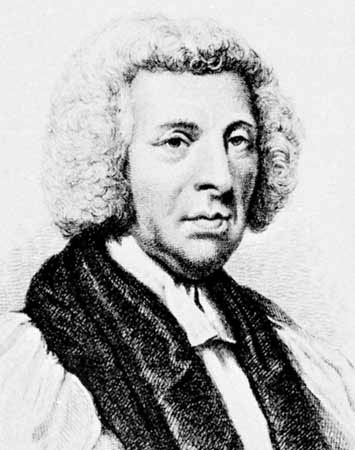
Bishop Percy (via Wikimedia Commons)
Scott had also from a young age collected chapbooks, cheaply printed eight or 12-page pamphlets sold by travelling ‘chapmen’ at fairs and door-to-door. These chapbooks often reproduced popular Scottish songs and ballads and gave him further incentive to publish the texts of what he had heard. Drawing on his knowledge of Border ballads and having organised annual ‘Raids’ into the then remote Liddesdale area near Jedburgh to listen to songs sung by locals, by the late 1790s Scott was ready to produce his own anthology. He was assisted by a network of local scholars and worthies who sent him manuscripts of ballads, and, above all, by his protégé, fellow Borderer John Leyden, whose shambolic appearance disguised a brilliant and inquisitive mind. Leyden proved indefatigable in tracking down manuscripts and persuading owners to hand them over and also in transcribing songs he heard. He urged Scott to expand his ambitions from producing a single five-shilling volume to a multi-volume work. Scott’s generosity of spirit and charisma also played a role in getting people to co-operate with him; his personality was in stark contrast with the usual public perception of the antiquarian as a curmudgeonly recluse.
By 1800 Scott had sufficient material to write to Cadell and Davies again, this time with a proposal to publish a two-volume work that would become ‘Minstrelsy’ (this letter is now in the Library’s Archive and Manuscript Collections, Acc.12733). Whereas the average aspiring author would have been content to simply send in his manuscript of his work, agree a price for selling the copyright, and let the publishers take care of the rest, Scott was far more hands-on in his approach. He stipulated in his letter to Cadell and Davies that his childhood friend (and fellow freemason) James Ballantyne of Kelso should do the printing. Scott also wanted the famous wood engraver Thomas Bewick of Newcastle-upon-Tyne to do two vignettes, but this request was declined; Scott had to make do with an engraving of Hermitage Castle near Newcastleton as the frontispiece to volume one of ‘Minstrelsy’. Despite the various conditions attached by Scott, Cadell and Davies agreed to publish the work and to allow Ballantyne to do the printing, even though he was a relative newcomer to the printing industry. His main experience was as the printer of the ‘Kelso Mail’, a newspaper which espoused the same Tory politics as Scott. It would be the beginning of a long and fruitful collaboration between Scott and Ballantyne.
A print run of 800 copies was agreed. The Edinburgh publishers Manners and Miller would receive 100 copies, Scott seven copies for himself, and Cadell and Davies would be sent the remaining 693 copies. Cadell and Davies sent paper to Ballantyne and printing began in 1801. In November 1801 Scott wrote to the publishers to inform them that “a variety of circumstances … have unavoidably retarded the work”, but it was now almost entirely printed and ready for publication on 1 January. He had another request, this time regarding promotion of the work; as well as in the usual publications, it should also be advertised in Ballantyne’s ‘Kelso Mail’. An advertisement duly appeared in ‘The Sun’ newspaper of London for 31 December 1801:
‘Speedily will be published, elegantly printed in two volumes octavo, Minstrelsy of the Scottish Border.’
In the issue for January 1802, the ‘Scots Magazine’ also included a discussion of the forthcoming publication, which was something of a puff piece:
‘The Kelso press … promises to vie with the finest exhibitions of typography, in other countries, has just produced a work, which… will attract the attention of men of literature, not only in Scotland, but in every country which has preserved a taste for poetical antiquities and popular poetry.’
The anonymous author even weighed its possible merits against the hitherto most famous collection of Scottish verse, James Macpherson’s Ossianic poems.
The planned New Year’s Day publication date proved to be premature. Copies were not ready for shipment from Kelso until the end of January 1802. On 6 February Ballantyne sent off three boxes, containing the 693 copies of ‘Minstrelsy’, to London on board the ‘Neptune’ from Berwick-upon-Tweed. With the books safely in London later that month, there was only the issue of the retail price to be sorted. Once again Cadell and Davies were willing to let Scott have his say on this matter. They noted that they would need to charge at least 18 shillings for a set in a publisher’s card and cloth binding “to produce even the most moderate Profits to Editor and Bookseller … a Price that, even in these Times, when all Books are so dear, will be thought immoderately high.” The advertisements for the book were right to mention its elegant printing. Ballantyne was not frugal when it came to using the paper (then a very expensive commodity) that he had received from London. The text was surrounded by generous margins and spacing, which no doubt pushed the price up. Scott consulted with Manners and Miller of Edinburgh, who already had advance orders for all their 100 copies, and they recommended a higher price of a guinea. Scott, however, stuck with Cadell and Davies’s recommendation of 18 shillings, still a tidy sum in those days (around £80 in today’s money), and well beyond the reach of the kind of working people who had traditionally sung these ballads.
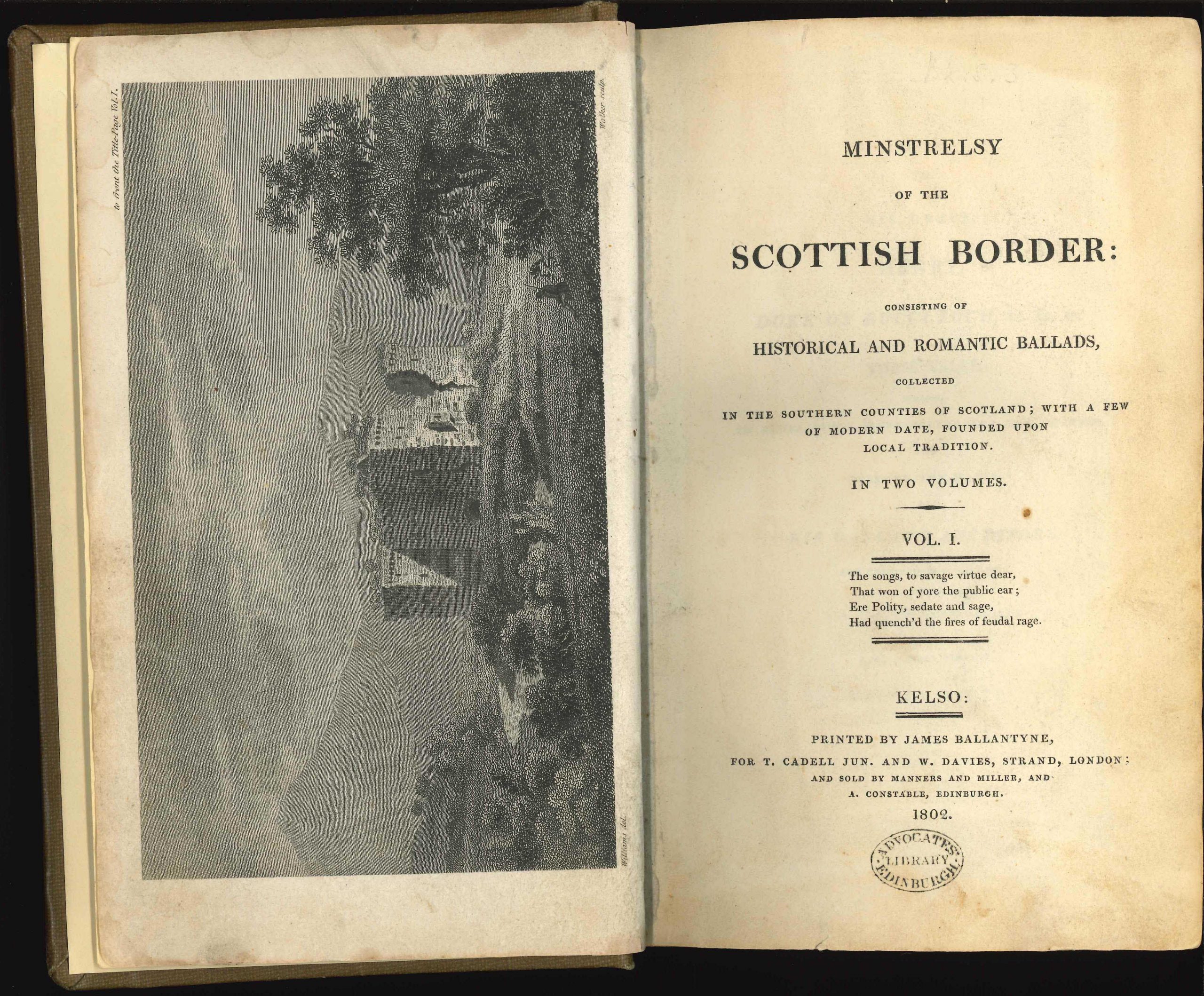
Image of first edition of Minstrelsy (1802)
‘Minstrelsy’ appeared in London bookshops on 9 March 1802, having already gone on sale in Edinburgh a couple of weeks earlier. Scott had originally planned the work to include only ‘Riding Ballads’ related to historical incidents, notably the old Border raids, but the first edition of the ‘Minstrelsy’ contained 29 historical and 24 romantic ballads. In that way he could cater to the tastes of a wider audience. Like Percy, he subscribed to the theory that the surviving ballads had come from one original source, a minstrel composing a particular ballad back in the mists of time. His approach for each ballad was to produce an improved version of the text which he felt read the best. He had no scruples when examining the various versions of ballads to change words, add new stanzas, alter rhymes, in effect bringing together various versions into a new composite version which he felt best represented the text. His intention was “to recover the rhyme” and “to remove obvious corruptions, and fit the ballads for the press”. The 1802 edition of ‘Minstrelsy’ also contained two previously published imitation ballads, ‘Glenfinlas’ and ‘The Eve of St John,’ largely written by Scott, and Scott’s own ‘Third Part’ to the traditional ballad ‘Thomas the Rhymer’.
Another similarity with Percy’s ‘Reliques’ was the absence of any printed music to accompany the text. Scott would later admit in his journal:
“I do not know and cannot utter a note of music; and complicated harmonies seem to me a babble of confused though pleasing sounds. Yet songs and simple melodies, especially if connected with words and ideas, have as much effect on me as on most people.”
The end effect was to give the impression that these ballads had been recited, rather than sung, and, as James Hogg’s mother famously accused him, making these texts available in print would mean the oral transmission of the texts through song would die out. Scott would no doubt have argued that the oral tradition in southern Scotland was dying out anyway. By committing the texts to print he was preserving them for posterity and giving them a new audience far beyond their original range. He treated the music as something extrinsic to the texts. Moreover, the costs and effort involved in collaborating with a musician and adding engraved music to the texts would have increased the costs and further delayed the publication. George Thomson’s and James Johnson’s works, ‘A select collection of original Scottish airs’ and ‘The Scots musical museum’, both of which would, from the 1790s onwards, bring Scottish folk music and songs to an international audience, took several years to produce. Basic musical notations of the ballads in ‘Minstrelsy’ only appeared in the first two volumes of the 1833 edition of Scott’s poetical works.
Scott’s approach to editing the ballad texts would not find favour with a modern scholar, but he had produced a definitive and exciting collection of Scottish ballads that would become a cornerstone of British ballad literature. Moreover, he had also prefaced them with an introduction of more than 100 pages and included five appendices, in which he displayed his antiquarian scholarship, using the methods employed by Percy and others, but with a new, less fustian, and more accessible, approach. ‘Minstrelsy’ was not the first collection of texts of Scottish ballads and songs published. David Herd’s ‘The ancient and modern Scots songs’ was first published in Edinburgh in 1769 (Herd would later allow Scott to use his manuscript collections for ‘Minstrelsy’). The Hawick printer George Caw had also published an anthology of songs in 1784, ‘The poetical museum’. James Hogg, later to make a significant contribution to the second edition of ‘Minstrelsy’, had ‘Scottish pastorals, poems, songs, &c.’, published in Edinburgh in 1801, although the book made little impression on the Edinburgh literati. In comparison, Scott’s work was a luxury item, something bigger, better, and more impressive than what had gone before.
No sooner had the first edition appeared than Scott was already making plans for a second edition, with an additional volume. He had been introduced to James Hogg in the previous year and Hogg was able to supply him with more ballads, later claiming to have contributed most of the material for the third volume of the second edition. Scott began to negotiate with Cadell and Davies for a new expanded edition, promising that the additional volume would be “more generally attractive than the two former as both the poetry & literary discussions will be less local”. Cadell and Davies appear to have been reluctant to commit to a new edition. The 693 copies were selling more slowly in London than in Edinburgh. Scott would later admit, in an introduction to an 1830 edition of ‘The lay of the last minstrel’, that the early editions of ‘Minstrelsy’ had not been a hit with the London reading public:
“The curiosity of the English was not much awakened by poems in the rude garb of antiquity, accompanied with notes referring to the obscure feuds of barbarous clans, of whose very names civilized history was ignorant. It was, on the whole, one of those books which are more praised than they are read.”
In the spring of 1802, however, Scott could barely conceal his impatience with his publishers, offering to sell the copyright for his proposed three-volume edition for what he considered to be a knockdown price of £500. Finally, on 28 April, with 200 copies of the first edition still to be sold, Cadell and Davies declined his offer. Their decision was only a temporary setback for Scott. He was now free to find another publisher and negotiated successfully that same year with Archibald Constable of Edinburgh and Constable’s friend, Thomas Longman, of Longman and Rees in London, for a second edition. Both Constable and Longman recognised Scott’s potential as a poet and author in his own right. He may have been primarily acting as compiler and editor for ‘Minstrelsy’, but in the imitation ballads and his introduction he had shown his abilities as an author. Their instincts proved to be correct. The second edition of ‘Minstrelsy’ may have sold poorly in 1803, and his edition of the Middle English romance ‘Sir Tristrem’ (1804) was a small-scale publication, but his narrative poem ‘The lay of the last minstrel’ (1805), following the template set by ‘Minstrelsy’, was an immediate and huge success on both sides of the border.
Scott’s half-share of the profits of the first edition ‘Minstrelsy’ amounted to £78 (around £800 in today’s money). What had started out as an antiquarian passion for old ballads had become a successful business venture. He had monetised texts which had previously been freely transmitted as part of an oral tradition. He continued to collect ballads for the rest of the decade. A volume containing Scott’s collection of manuscript ballad texts from Hogg and other contributors is now in the Library’s Archive and Manuscript Collections, (MS.877). By the time of the fifth edition (1812), there were 96 ballads in the collection. American editions and translations into other languages followed. The work was an important landmark in the career of Scott, establishing his literary reputation and enabling him to make his living by writing.
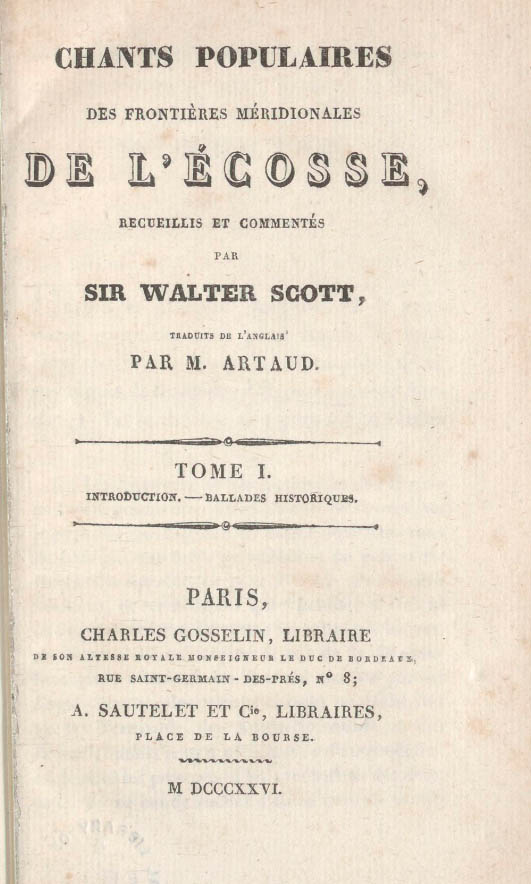
Image of a French edition of Minstrelsy (1826)
Further reading:
J. Millgate, ‘The Early Publication History of Scott’s ‘Minstrelsy of the Scottish Border’’, The Papers of the Bibliographical Society of America, Vol. 94, No. 4 (December 2000), pp. 551-564.
C. Zug, Sir Walter Scott, Robert Jamieson and the New ‘Minstrelsy’, Music & Letters, Vol. 57, No. 4 (October 1976), pp. 398-403
W. Montgomerie, ‘Sir Walter Scott as a ballad editor’, The Review of English Studies, Vol. 7, No. 26 (April 1956), pp. 158-163.
M.R. Dobie, ‘The development of Scott’s Minstrelsy: an attempt at a reconstruction’, Edinburgh Bibliographical Society Transactions (2/1, session 38–39).
